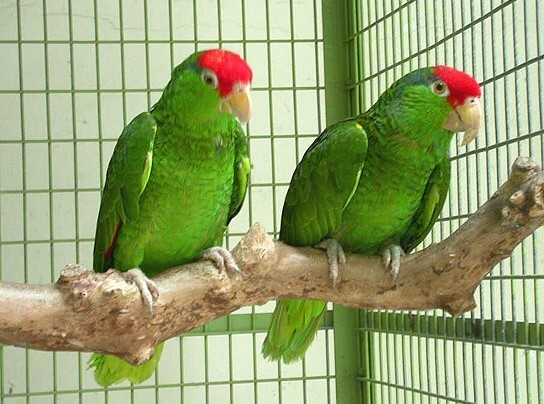Red-crowned Amazon
A species of Amazon parrots, Also known as Green-cheeked Amazon Scientific name : Amazona viridigenalis Genus : Amazon parrots
Red-crowned Amazon, A species of Amazon parrots
Also known as:
Green-cheeked Amazon
Botanical name: Amazona viridigenalis
Genus: Amazon parrots
Content
Description People often ask General Info
 Photo By TJ Lin , used under CC-BY-SA-2.0 /Cropped and compressed from original
Photo By TJ Lin , used under CC-BY-SA-2.0 /Cropped and compressed from original Description
Their appearance is generally green with the most notable features being a bright red forehead and crown, dark blue streak behind the eyes, and light green cheeks. It is not uncommon for Red-crowned Amazons to have splashes of red and blue under their wings and have light yellow-tipped tails. They have a white eye-ring which brings out their eyes. Their iris color can range from a bright yellow to a deep red, although juveniles' eyes are gray until maturity. Red-crowned amazons usually have horn colored beaks and ceres but these can sometimes have black highlights. Their legs are flesh-colored or gray. They are approximately 11-13 inches in length from the beak to the tip of the tail feathers with a wingspan of 15-16 inches. Amazon parrots are not sexually dimorphic, so the only true way to know a parrot's sex is by genetic testing. Their average weight is 270g. 
Size
30-33 cm (12-13 in)
Colors
Green
Yellow
Red
Blue
Life Expectancy
50-70 years
Nest Placement
Cavity
Clutch Size
2 - 5 eggs
Incubation Period
1 brood
Number of Broods
25 - 31 days
Nestling Period
53 days
Feeding Habits
Red-crowned Amazon's diet primarily comprises seeds and fruits from tropical plants, such as sweet acacia, strangler fig, and various passionflowers. They forage high in the trees and use their bill and feet to handle food, feeding methodically. They consume acorns, pine seeds, walnuts, pecans, and insects for their young. Red-crowned Amazons forage in flocks, most active in mornings and afternoons.
Habitat
Red-crowned Amazon's habitat includes arid lowlands and foothills, particularly in lowland deciduous forests, pine-oak woodlands, and agricultural regions with significant trees. These birds flourish in environments with sabal palms and Texas wild olives at suitable elevations. They're also found in suburban and urban areas that provide nests and varied food sources. Their natural range encompasses southern Texas to northeastern Mexico, with adaptability to forest fragments and riparian zones.
Nest Behavior
Red-crowned Amazon females select the nesting site and lay eggs directly on the cavity floor, unlined. The nesting period entails egg-laying directly in the previously chosen site, followed by parental care to ensure offspring survival.
Nest Characteristics
Red-crowned Amazon typically nests in natural tree cavities or previous woodpecker holes, favoring open or disturbed habitats and forest edges. Chosen cavities have a minimum 2.2-inch entrance and are typically at least 9 inches deep with a 5.1-inch diameter.
Dite type
Frugivorous
People often ask
General Info
Feeding Habits
Bird food type

Fruit
Behavior
Red-crowned Amazon are monogamous birds, pairing for life, with females maturing at around five years of age. They exhibit a strong pair bond, emphasized by mutual food-begging and -feeding behaviors observed while mating and nesting. Communication is key for red-crowned Amazon, as couples use unique calls to coordinate during the nest selection process. These birds are relatively sedentary with regard to their home ranges, yet they can be surprisingly nomadic in their search for food. Post-breeding season, red-crowned Amazon form larger flocks, demonstrating remarkable social dynamics, such as communal roosting and minimal conflict over resources, even when nesting proximately. A distinctive threat display involving bill gapping and wing extension is reserved for encroaching Amazona species, highlighting their territorial nature. Day-to-day, red-crowned Amazon engage in a blend of feeding, flying, preening, napping, and social interactions, punctuating their routines with vocal commutes to foraging sites at dawn.
Distribution Area
Their natural range is across the lowlands of northeastern Mexico, and possibly the southern tip of Texas. Red-crowned amazons are a resident (non-migratory) species in their native range, but they can wander outside of their breeding range to follow a food source. Feral birds have bred in urban communities of southern California, southern Florida and the island of Oahu in Hawaii. On June 4th, 2019, the Corpus Christi Ecological Services Field Office of the US Fish & Wildlife Service announced to the public that the USFWS considers the red-crowned parrot native to Texas in the Rio Grande Valley. However, because parrots were not mentioned in the Migratory Bird Treaty Act of 1918, birds in the Texas portion of their range are not entitled to USFWS protection, and must rely on enacted state and local laws. It is considered an Imperiled species (S2) in Texas. The USFWS estimated that there are roughly 700 red-crowned parrots wild in the Rio Grande Valley of Texas in 2019, and historical records place parrots in South Texas as early as 1885. The numbers of wild parrots in the U.S. now rivals populations in Mexico due to their adaptation to urban life. However, the IUCN and other resources consider the bird to be non-native to all parts of the United States, including southern Texas. Red-crowned amazons nest in tree cavities, like most other parrots.
Species Status
ENDANGERED. A BirdLife “restricted-range” species, confined to 7800 km2 on the Atlantic coastal plane of NE Mexico.
Scientific Classification
Phylum
Chordates Class
Birds Order
Parrots Family
Parrots Genus
Amazon parrots Species
Red-crowned Amazon